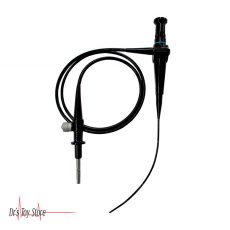Olympus CF-1T100L Colonoscope
Introducing the Olympus CF-1T100L Colonoscope for sale.
Olympus CF-Type Q160S Colonoscope Features
- Large 4.2 mm instrument channel
- Unrivaled image quality with superior life-like color reproduction
- Compatible with CV-180, CV-160, CV-140 and CV-100 video processors
Olympus CF-Type Q160S Colonoscope Specifications
- Optical System
- Field of View: 140°
- Direction of View: Forward
- Depth of Field: 5 to 100 mm
- Insertion Tube
- Insertion Tube Outer Diameter: 13.7 mm
- Bending Section
- Angulation Range: Up 180° | Down 180° | Right 160° | Left 160°
- Instrument Channel
- Inner Channel Diameter: 4.2 mm
- Working Length: 1680 mm
- Total Length: 1980 mm
Colonoscopy remains the gold-standard investigation for inspecting the mucosa of the colon for pathology such as cancer, adenomas, or inflammation. It remains preferable, in many situations, to other imaging modalities such as computed tomography (CT) colonography or barium enema due to the capacity to intervene and sample or remove pathology encountered.
Emerging evidence over the last 5 years has led to important changes in the practice of colonoscopy throughout the patient journey. This review will focus on important practical developments and areas of interest. We will look at all aspects of colonoscopy, from the preparation, through the procedure and endoscopic therapy, to safety and quality assurance.
A colonoscopy is an outpatient procedure in which the inside of the large intestine (colon and rectum) is examined. A colonoscopy is commonly used to evaluate gastrointestinal symptoms, such as rectal and intestinal bleeding, or changes in bowel habits. Colonoscopies are also performed for colorectal cancer screening in individuals without symptoms to check for colorectal polyps or cancer. A screening colonoscopy is recommended for anyone 50 years of age and older (45 for African Americans), and for anyone with parents, siblings, or children with a history of colorectal cancer or polyps.
Colonoscopy and sigmoidoscopy are procedures that let the doctor look inside large intestine. They use instruments called scopes. Scopes have a tiny camera attached to a long, thin tube. The procedures let the doctor see things such as inflamed tissue, abnormal growths, and ulcers.
Colonoscopy checks entire colon and rectum. Sigmoidoscopy checks the rectum and the lower colon only.
The doctor may recommend one of these procedures
- To look for early signs of cancer in the colon and rectum. It may be part of a routine screening, which usually starts at age 50
- To look for causes of unexplained changes in bowel habits
- To evaluate symptoms like abdominal pain, rectal bleeding, and weight loss
The doctor can also remove polyps from colon during these procedures.












Reviews
There are no reviews yet.